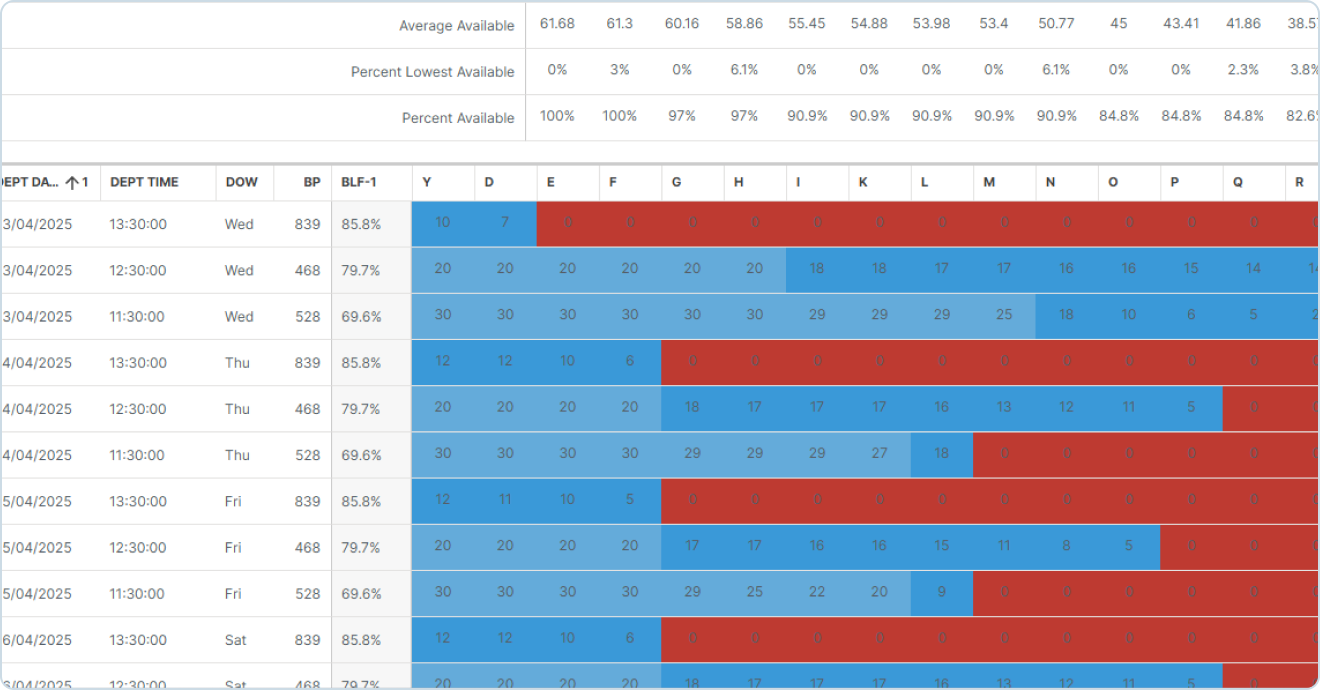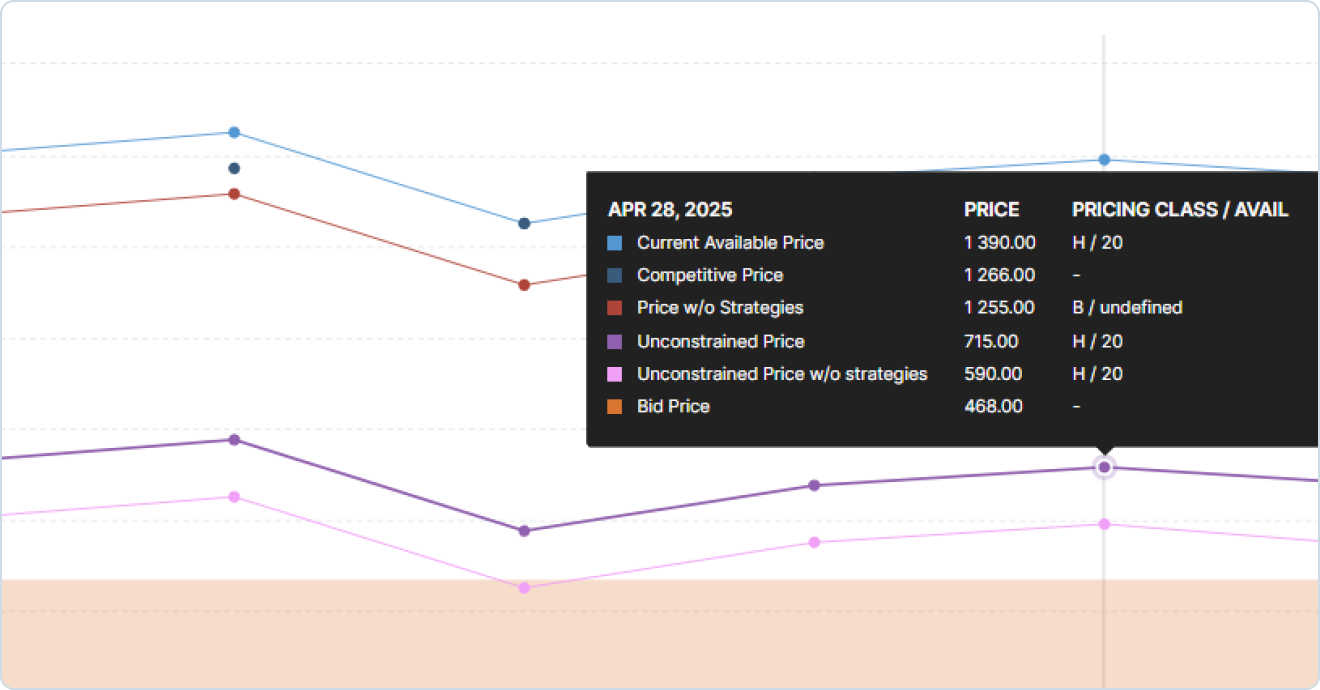Airlines & Travel: Real-Time Dynamic Pricing

Right Price, Right Now
Drive more conversions with real-time pricing and availability
Move beyond fixed, class-based fares with dynamic pricing based on real-time analysis of the price elasticity of demand. PROS Real-Time Dynamic Pricing helps teams confidently and accurately set prices across all sales channels and partner sites.- Increase Conversions at Scale
- Reduce Revenue Leaks
- Future-Ready Pricing
Deliver accurate, competitive offers instantly across all your sales channels to drive more bookings. PROS Real-Time Dynamic Pricing processes over 13 billion requests each day—more than all daily, global credit card transactions and Google searches combined—and runs 24/7 with an incredible 99.99% uptime for fast, reliable pricing at scale.
Help prevent buy-down and revenue leaks by setting the right price for every passenger—and for you. PROS Real-Time Dynamic Pricing acts as a price recommendation engine, helping airline analysts manage price elasticity, and apply dynamic pricing strategies to drive stronger revenue performance.
Move toward class-free pricing with a dynamic, future-ready approach. PROS Real-Time Dynamic Pricing calculates prices based on customer price sensitivity, preparing your airline for the shift to Offer Management while still supporting legacy systems by mapping dynamic prices to class codes in real time.
Handles
13B+
Transactions Daily
Up to
3.5%
Direct Revenue Uplift
with Continuous and Request-Specific Pricing
99.99%
Uptime
for seamless, uninterrupted performance
AI & Science

Continuous Pricing
PROS Real-Time Dynamic Pricing supports AI-driven continuous pricing, helping airlines offer fares between predefined price levels instead of relying on rigid class-based pricing. This scientific approach uses real-time data and advanced algorithms to adjust fares dynamically, capturing hidden demand and increasing revenue with more precise, market-responsive pricing.

Request-Specific Pricing (RSP)
Request-Specific Pricing (RSP) in PROS Real-Time Dynamic Pricing uses AI to analyze aggregate historical bookings information, estimating price elasticity at a granular level. By integrating these insights with availability and continuous pricing models, Real-Time Dynamic Pricing helps to enhance pricing flexibility and maximize revenue.
Integrations
PROS Real-Time Dynamic Pricing offers seamless integrations with Revenue Management Systems (RMS), Shopping engines, PROS Group Sales Optimizer (GSO), Global Distribution Systems (GDS), Passenger Service Systems (PSS), and more, helping you ensure your pricing strategy is always connected, efficient, and responsive.



By leveraging PROS dynamic pricing technology, we’ve created more tailored and flexible pricing options, improving customer experience and driving revenue growth.

Stefan Kreuzpaintner
Senior VP, Commercial Customer Offer, Lufthansa Group
Features
Dynamic Availability
Adjust seat availability and pricing in real time across sales channels. Using data-driven insights, airlines can create targeted fare strategies to match market conditions, passenger attributes, and demand—driving revenue and smarter sales.
Continuous Pricing
Move beyond traditional filed fare levels and static price points. Offer indefinite price points tailored to passenger demand and market conditions, so you can capture hidden demand and maximize revenue.
Request-Specific Pricing (RSP)
Tailor fares based on passenger interest, preferences, and shopping context. This precise, AI-driven approach helps you capture more demand, increase revenue, and reduce manual workload for analysts.
Availability Workflow & Simulation
Monitor and help optimize availability in real time. Test rule changes and strategies before implementation without impacting live transactions.
Competitive Strategies
Maximize revenue by automatically adjusting pricing based on real-time competitor fare insights.
Business Analytics
Gain insights with performance metrics on availability and sell requests by market, channel, PCC, and POS to detect issues and take action.
Abuse Prevention
Help protect revenue and ensure fair booking practices with tools like Marriage Segment Controls, RV Equalizer, and Revenue Integrity Reports.
Pricing Chart
Make more informed and effective decisions. Gain an extensive view of your pricing strategies by visualizing how availability impacts offered prices.
Fare Viewer
Improve pricing decisions by tracking fare progression—daily or transformed—to gain deeper insights into availability and adjustments.
Real-Time Availability Across Partners
Editions
Advantage
Great for airlines looking for more flexibility and control using dynamic availability management. Build the foundation for dynamic pricing and manage price elasticity with winning fare, market, and competitive strategies.
Option to add on Real-Time Partner Availability and Real-Time Inventory Connector for greater performance and efficiency.
Ultimate
Designed for airlines on the path to class-free dynamic pricing and modern retailing. Increase revenue and pricing precision with the power of continuous pricing and request-specific pricing, delivering competitive and profitable fares tailored to customer demand.
Bringing Continuous Pricing to Life with PROS RTDP
Discover how airlines can adopt continuous pricing while maintaining legacy systems, featuring insights from Air Canada, the Lufthansa Group, and PROS.
Book a Demo With An Outperformance Expert
Meet with a PROS professional. Put the product—and our service—to the test. Together, we’ll help your company perform to its potential.
FAQs
How does PROS Real-Time Dynamic Pricing (RTDP) help increase revenue?
By continuously adjusting fares based on customer behavior, market demand, and real-time insights, airlines can maximize revenue and reduce revenue leaks.
Can PROS Real-Time Dynamic Pricing (RTDP) integrate with our existing revenue management system?
Yes, PROS RTDP is integrated with PROS Revenue Management to help ensure the seamless execution of your airline’s RM strategy and a smooth transition to dynamic pricing. PROS RTDP also integrates with Revenue Management Systems (RMS), Global Distribution Systems (GDS), and Passenger Service Systems (PSS).
How does Request-Specific Pricing work?
It uses AI to assess passenger information and preferences, shopping context, and historical booking trends to offer the most relevant price.
What makes PROS Real-Time Dynamic Pricing (RTDP) different from traditional availability management?
Unlike traditional systems, PROS RTDP focuses on pricing optimization, not just fare availability, helping airlines consider margin and price sensitivity, implement smarter, more flexible pricing strategies.
How does PROS Real-Time Dynamic Pricing (RTDP) help prevent revenue loss?
PROS RTDP helps prevents spillage (underpricing) and spoilage (overpricing) by dynamically adjusting prices to match real-time demand and market trends.
Is PROS Real-Time Dynamic Pricing (RTDP) future-resistant for Offer and Order Management?
Yes, PROS RTDP supports the transition to class-free dynamic pricing, so airlines are ready for the next evolution in airline retailing.
Additional Resources
Key Strategies for Implementing Airline Dynamic Pricing
As NDC adoption grows, dynamic pricing is a top priority for airline leaders. This blog series explores real-world strategies and tactics to help revenue, eCommerce, and distribution teams bridge the gap between RBDs and class-free pricing.
- read more
What Exactly is Dynamic Pricing in the Airline Industry?
- read more
3 Ways to Fast-track to Airline Retail Freedom
The airline industry is seeing increased adoption of retail transformation initiatives centered on NDC and Offer & Order management. These efforts aim to enhance the traveler experience and free airlines from legacy technology constraints.
- read more


